Today’s installment in our series of Vintage Lighter Reviews will focus on the most unique lighter I have ever owned, the Swiss made NIKA petrol lighter. There are multiple design elements including the flint tension set-up and seemingly misplaced file roller that may cause confusion but certainly make it stand out from the crowded field of petrol lighters in general and aluminum block lighters more specifically.
You’ve Seen One, You’ve Seen Them All?
(Aesthetic Appeal)
Perhaps a little more “blocky” than most, the NIKA is somewhat thick from front to back providing a wide profile compared with most roller lighters. But the NIKA is not your run-of-the-mill roller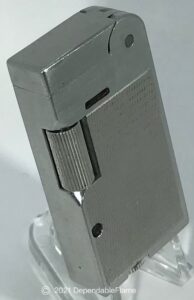 lighter. It is a very interesting design with a hinged snuffer that provides stability of function and design which are typical lacking in the pantheon of vintage aluminum block petrol lighters.
lighter. It is a very interesting design with a hinged snuffer that provides stability of function and design which are typical lacking in the pantheon of vintage aluminum block petrol lighters.
The placement of the file roller will catch the eye of some lighter enthusiasts and may even lead you to believe the mechanism was meant to be manipulated in a certain manner by a left-handed operator. The direction the file wheel is rolled however, will quickly convince one otherwise of an other-handed disposition of operation. The appearance of the roller on the off-side is still of note.
What at first may seem like any other old roller or aluminum block lighter you’ve seen before, while still being attractive, might yet leave you speechless at the effort to install a flint or simply strike the lighter.
Not So Fast My Little Friend!
(Imagination Of Mechanism)
The mechanisms employed on the NIKA seem to have had some active imaginations involved in their designing. I have posited in the past that if someone is going to design a lighter today in the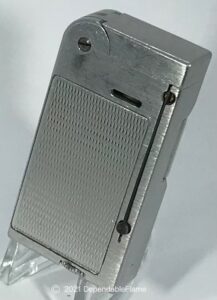 here and now, there should be improvement made on previous designs and not simply copy designs that have worked in the past.
here and now, there should be improvement made on previous designs and not simply copy designs that have worked in the past.
Everyone talks about Asian knock-offs from just about every period of petrol lighter manufacture. With a knock-off, there’s no real design work going on but simply copying a design previously proven successful by another manufacturer.
That’s not the case with the NIKA however, as the flint tension system is accomplished with a long, heat treated steel arm spring mounted by the use of a round peg on one end, slid and held stable into a hole of the same size cut out of the body of the lighter. The hole goes all the way through allowing simple removal when pressure is applied with an implement from the other side to the end of the peg that was slid in first. It’s much different from any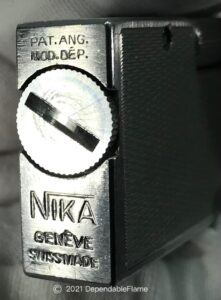 other flint tension system I have run across and initially had me baffled.
other flint tension system I have run across and initially had me baffled.
The roller is also a design of an untypical nature being on the front right as opposed to the left front position of most rollers. It is readily removed without the need for tedious or small tools, perhaps requiring only a small standard screwdriver if the mechanism is screwed down tight. A left-handed motion will loosen the screw that holds the roller in place, negating any possibility the lighter may have been designed specifically for such use.
How Does This Lighter Work?
(Overall Functionality/Ease Of Use).
Two-handed may have been the fashion its designer intended the NIKA to be struck as I had no problems when lighting it in this manner. Most roller lighters seem to me to be intended for one-handed, right-handed ignition. Go watch any of my Cygnus lighter videos and you’ll see what I mean. Typically, leaning to the left with the right thumb resting on top of the roller and striking it downward is the way to go.
videos and you’ll see what I mean. Typically, leaning to the left with the right thumb resting on top of the roller and striking it downward is the way to go.
Manipulating the NIKA in this manner though is a little awkward and feels out of whack. The position of the file wheel in relation to the wick and the placement of the roller certainly contribute to this and make me wonder about the reason the roller was placed on the right to begin with.
That’s not the only curious element that went into the design of this lighter as the flint tension spring itself has often caused me to ponder what made its design necessary or was the inventor simply being novel? It’s not much of a stretch to conceive the situation at the time requiring the use of alternate materials as was necessitated by some metals being unavailable do to wartime rationing or prioritization of use.
Ignorance Is Not Bliss…
(Embellishments/Materials/Finishes)
This example had nice, engine-turned designs on both sides of the lighter. I have recently seen a plain, brushed type aluminum finish lighter sell on Ebay. These two are the only NIKA branded lighters I have seen with the same unique flint tension and roller setup. I have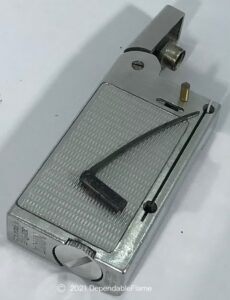 seen a few others listed on Ebay over the yrs that were branded NIKA in one way or another but had a more typical flint and roller setup. These more typical looking NIKA lighters may have also somehow been associated with the brand TONY.
seen a few others listed on Ebay over the yrs that were branded NIKA in one way or another but had a more typical flint and roller setup. These more typical looking NIKA lighters may have also somehow been associated with the brand TONY.
The NIKA that I owned was equipped with a fuel screw gasket and spare flint compartment in the fuel screw, both fairly typical accouterments among its aluminum block petrol lighter brethren. The precision of manufacture and artwork of the engine turning however, are not.
As this was an aluminum block lighter and the circumstances that necessitated the use of that material to begin with, I wouldn’t expect to find other NIKAs produced in other metals but that is just an informed guess on my part. I have not personally witnessed NIKAs with applied emblems, enameled motifs or any embellishment other than the attractive engine turning.
Owned One, Seen Two; How About You?
(Overall Grade Factoring In All Of The Above).
So, to total up and give this lighter a score, I would call it a 3.5 out of 4. For any aluminum block lighter collector specialist I would say the NIKA is a must own. Maybe the rarest and most unique of all aluminum block lighters and maybe even stretching outside the sphere of aluminums.
the NIKA is a must own. Maybe the rarest and most unique of all aluminum block lighters and maybe even stretching outside the sphere of aluminums.
It’s an attractive lighter even if it does have the air of a mirror image and appear somewhat awkward, so I give it a full point on the first category of appearance or aesthetic appeal. The engine turned design of course contributing to that appeal.
For the category of imagination of mechanism, I give it an enthusiastic full point as well. It’s not often that you run into a lighter with one unique mechanism that stands out, let alone two and that’s exactly what this lighter gives you with the flint tension and roller both being abnormal.
The functionality/ease of use category is the only place this lighter falls short as it is not only a puzzle to figure how to operate it but also why exactly it was designed in such a manner. In other words, I love the imagination that went into the mechanisms, just wish I knew why they were made the way they were.
I am admittedly somewhat ignorant of all or really any other embellishments the NIKA may have employed but even the engine turning alone is pretty noteworthy for an aluminum block lighter and thusly earns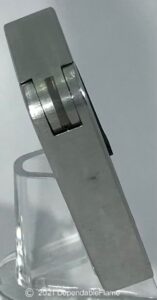 another full point in the last category. Aluminum block lighters being what they are rightly get a pass where other metals may not for lack of variety.
another full point in the last category. Aluminum block lighters being what they are rightly get a pass where other metals may not for lack of variety.
As always I would love to hear from you if you have info on this lighter that I may be lacking.
I hope you’ll check out our YouTube channel and tell all your friends we are in the business of demonstrating vintage petrol lighter repair and a broader scope of the entertainment value of cigarette lighters, ashtrays, tobacciana and other useful mechanisms.
Please leave any comments or questions at the bottom of this or any other article at DependableFlame.com.
Until next time….✌️
Hey there! I loved reading your review on the Nika Swiss Made Aluminum Block Petrol Lighter. As someone who appreciates vintage items, I found your description of the design and functionality of the lighter to be quite informative. The fact that it’s made of aluminum makes it even more unique!
I’m curious, have you come across any other vintage lighters that have a similarly distinctive design? Also, I noticed that the lighter is a petrol lighter. In your experience, do you find that petrol lighters are generally more reliable than other types of lighters?
Thanks for sharing your thoughts on this intriguing vintage item!
Thank you Jennyse, I really appreciate your stopping by! I think flint sparked petrol lighters are much easier to repair than other types. The NIKA was undoubtedly the most unique lighter I’ve ever come across but there are plenty of aluminum block lighters that are made in a similar style if not sporting the same mechanisms. Petrol lighters are also much more simple than butane lighters.✌️
I’d want to express my gratitude for the insightful and comprehensive assessment that you provided about Vintage Lighter. This is a highly intriguing post, so keep reading. In addition to that, I think his lighter is extremely appealing. I’ve used a refill lighter similar to this one in the past. On the other hand, I haven’t really paid that much attention to them. Because of your essay, I’m now curious about them. Keep publishing like this. I will most certainly pass this forward.
Thank you Pasindu, I appreciate you reading the article and am glad you enjoyed it. Vintage petrol lighters are a vast and varying field. I would like to cover them all eventually but there are so many that I have never even seen or had any experience with. Stay tuned, there are enough different lighters out there to keep me busy for awhile.✌️
I stumbled upon this article on Dependable Flame about a vintage lighter, and I couldn’t resist writing a comment about it. This article is a gem for anyone who appreciates fine craftsmanship and is looking for a unique lighter to add to their collection.
The Nika Swiss-made Aluminum Block Petrol Lighter is a design that truly stands out. Its sleek and sturdy aluminum block body is not only stylish but also provides great protection for the lighter’s inner mechanisms. The author of the article did an outstanding job in describing the lighter’s features and the craftsmanship that went into making it. It’s clear that the author has a deep appreciation for vintage lighters and understands the significance of this lighter’s design.
One thing I particularly liked about the article was the author’s personal experience with the lighter. It’s always great to hear someone’s firsthand account of using a product, and the author didn’t disappoint. Their description of the lighter’s performance and ease of use was helpful and added a personal touch to the article.
I do have a question for the author, though. How long have they been collecting vintage lighters? Do they have any other favorites in their collection?
Before I wrap up, I want to express my gratitude to the author for taking the time to write such a delightful and informative article. As someone who appreciates vintage lighters, it’s always great to come across someone who shares that passion and can provide insightful commentary on them. So, thank you for a wonderful read!
Thank you Bob, I really appreciate you taking the time to read and especially comment on this article. I hope it was as much fun for you to read as it was for me to write. Just add it was a pleasure to own and to use the NIKA lighter. To answer your questions, I have been working on and selling lighters for almost six yrs now but really only started collecting in the last couple. My favorites are the Penguin Cygnus, Thorens automatics and the Ronson Debonair. I made this video for a viewer to the DependableFlame.com YouTube channel who asked a similar question.✌️
Hi Joseph.
I know only a little about vintage lighters, but I have learned much from your article. I enjoyed the forensic exploration of the lighter, akin to the way I might explore a tech gadget but better.
I am curious. Why is aluminium an unusual material for vintage lighters? What would be the more usual material? Would this then impact the design and the features you describe?
The NIKA is a rare find. Interestingly, you mentioned it was intended for two-handed use. When you said that, I had a flashback of some of the black-and-white movies I have watched, and most of them seem to use one-handed lighters.
What kind of price do vintage lighters attract?
I enjoyed your exploration of the NIKA Vintage lighter. I have learned a lot. It also allowed me to take a trip down memory lane.
Whyjay
Hello Whyjay, I’m glad you enjoyed the article and you ask some very good questions! Aluminum was a surplus metal at a time from the end of WWII through the Korean War when brass and other metals were needed for the war effort. Brass has typically been the base metal, usually chrome or nickel plated. Aluminum can be anodized different colors, brass can be plated with many different metal finishes, so the base metal affects the finishes achievable. Thank you for stopping by, I hope this helps!✌️
Hi,
This article about the NIKA Swiss Made Aluminum Block Petrol Lighter is fascinating. The design is unlike any other lighter I’ve seen before, with unique design elements that make it stand out from the rest. The flint tension system and misplaced file-roller caught my eye, and I was impressed by the imagination and creativity that went into the mechanisms.
I appreciated the author’s in-depth analysis of the lighter’s functionality and ease of use. Although it may be somewhat awkward to manipulate, it’s still an attractive lighter with an engine-turned design that adds to its aesthetic appeal. I also found it interesting to learn about the various embellishments, materials, and finishes that may be associated with the NIKA.
Overall, I would give this lighter a score of 3.5 out of 4. It’s a must-have for any aluminium block lighter collector, and the imaginative mechanisms and unique design elements make it stand out from the rest. I enjoyed reading this article and would recommend it to anyone interested in vintage lighters.
Thank you Julia, I appreciate you stopping by. The NIKA is certainly unique among its vintage petrol lighter brethren and even among the smaller group of aluminum block lighters that came along because aluminum was surplus and other metals were needed for the war effort. It is very functional and has several design elements that set it apart from similar lighters of the time. I am glad you enjoyed reading the article and hope you will check back often as we publish a new article every Monday and Thursday at DependableFlame.com.
Please post a few pictures or a video of the flint being installed in this lighter. I have one of these and do not know how to get the flint loaded into the flint chamber. – June 27, 2023 – Jim Rich
Hey Jim, thank you for the question. I have added a video down toward the bottom of this article that illustrates how to install the flint beginning at around the 2:30 mark in the video. This is definitely one of the most unique lighters that I have every owned and I was really intrigued by its design. I have since seen a couple others sell on Ebay but it really does appear to be one of the more scarce lighters that can be encountered. I would love to hear back from you once you get it working and learn what you think about the way that it functions.